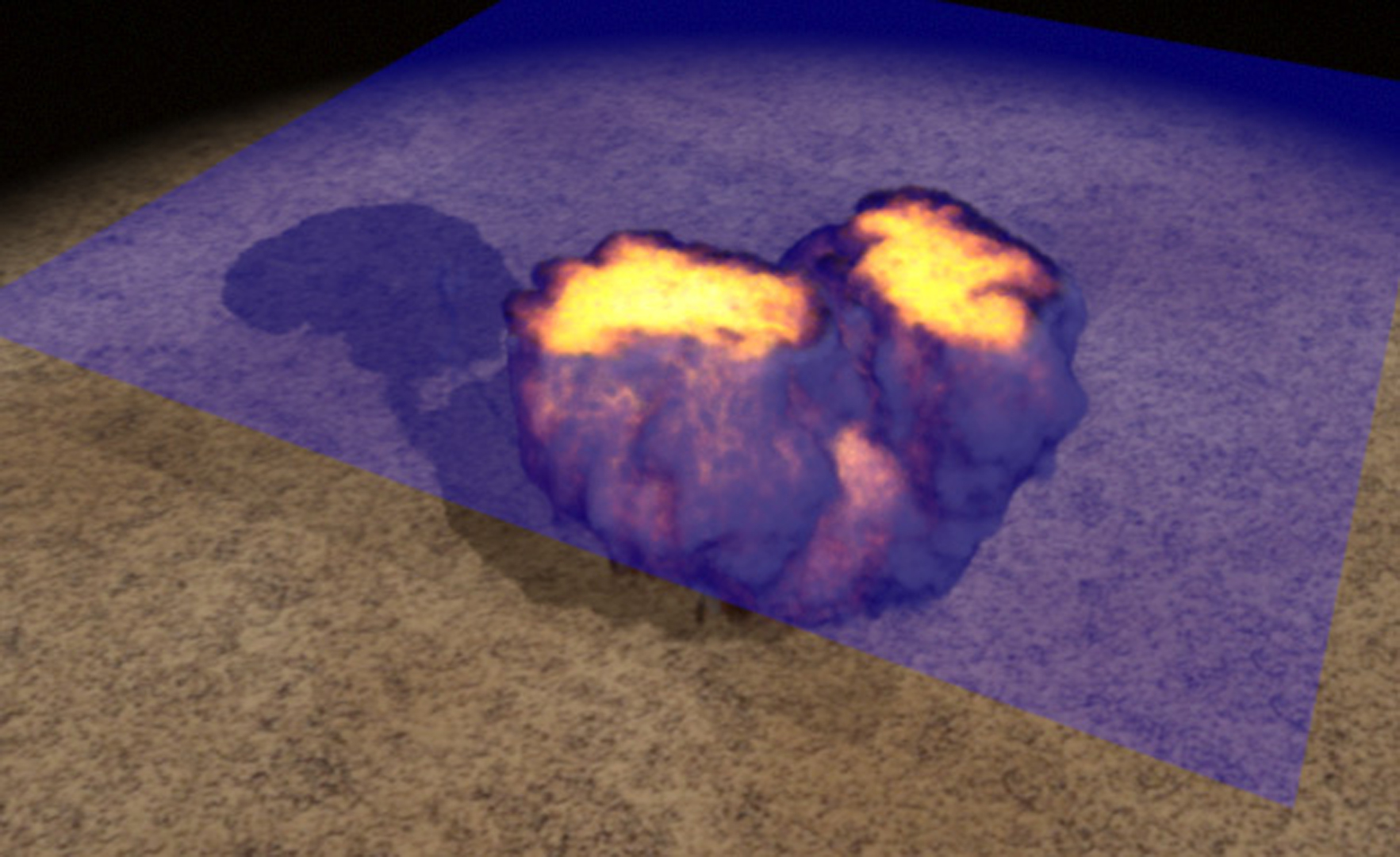“Animating suspended particle explosions” by Feldman, O’Brien and Arikan
Conference:
Type(s):
Title:
- Animating suspended particle explosions
Presenter(s)/Author(s):
Abstract:
This paper describes a method for animating suspended particle explosions. Rather than modeling the numerically troublesome, and largely invisible blast wave, the method uses a relatively stable incompressible fluid model to account for the motion of air and hot gases. The fluid’s divergence field is adjusted directly to account for detonations and the generation and expansion of gaseous combustion products. Particles immersed in the fluid track the motion of particulate fuel and soot as they are advected by the fluid. Combustion is modeled using a simple but effective process governed by the particle and fluid systems. The method has enough flexibility to also approximate sprays of burning liquids. This paper includes several demonstrative examples showing air bursts, explosions near obstacles, confined explosions, and burning sprays. Because the method is based on components that allow large time integration steps, it only requires a few seconds of computation per frame for the examples shown.
References:
1. BASHFORTH, B., AND YANG, Y.-H. 2001. Physics-based explosion modeling. Journal of Graphical Models 63, 1 (Jan.), 21–44. Google Scholar
2. BEAUDOIN, P., PAQUET, S., AND POULIN, P. 2001. Realistic and controllable fire simulation. In Graphics Interface 2001, 159–166. Google ScholarDigital Library
3. BUKOWSKI, R., AND SÉQUIN, C. H. 1997. Interactive simulation of fire in virtual building environments. In Proceedings of ACM SIGGRAPH 97, 35–44. Google ScholarDigital Library
4. CASHDOLLAR, K. L., 1986. Coal-dust explosion propogating outward from the mine portal. Symposium on Industrial Dust Explosions, June.Google Scholar
5. CASHDOLLAR, K. L. 2000. Overview of dust exportability characteristics. JOURNAL of Loss Prevention 12, 183–199.Google ScholarCross Ref
6. CASHDOLLAR, K. L., 2002. Personal communication, Nov.Google Scholar
7. CHIBA, N., OHKAWA, S., MRURAOKA, K., AND MIURA, M. 1994. Two-dimensional visual simulation of flames, smoke and the spread of fire. The Journal of Visualization and Computer Animation 5, 1, 37–54.Google ScholarCross Ref
8. DALTON, P., ROSENBLUM, R., HUANG, S.-C., LEE, L., AND DRISKILL, H. 2002. Digital pyro for reign of fire. In Visual Proceedings of ACM SIGGRAPH 2002, 167. Technical Sketch. Google Scholar
9. FEDKIW, R., STAM, J., AND JENSEN, H. W. 2001. Visual simulation of smoke. In Proceedings of ACM SIGGRAPH 2001, 15–22. Google Scholar
10. FOSTER, N., AND METAXAS, D. 1997. Modeling the motion of a hot, turbulent gas. In Proceedings of ACM SIGGRAPH 97, 181–188. Google ScholarDigital Library
11. JENSEN, H. W., AND BUHLER, J. 2002. A rapid hierarchical rendering technique for translucent materials. In Proceedings of ACM SIGGRAPH 2002, 576–581. Google Scholar
12. LAMORLETTE, A., AND FOSTER, N. 2002. Structural modeling of natural flames. In Proceedings of ACM SIGGRAPH 2002, 729–735.Google Scholar
13. LEE, H., KIM, L., MEYER, M., AND DESBRUN, M. 2000. Meshes on fire. In EuroGraphics 2000 Workshop on Animation. Google Scholar
14. LOKOVIC, T., AND VEACH, E. 2000. Deep shadow maps. In Proceedings of ACM SIGGRAPH 2000, 385–392. Google Scholar
15. MARTINS, C., BUCHANAN, J., AND AMANATIDES, J. 2002. Animating real-time explosions. The Journal of Visualization and Computer Animation 13, 2, 133–145.Google ScholarCross Ref
16. MAZARAK, O., MARTINS, C., AND AMANATIDES, J. 1999. Animating exploding objects. In Graphics Interface 99, 211–218. Google ScholarDigital Library
17. MCGRATTAN, K. B., ET AL. 2002. Fire dynamics simulator (version 3) technical reference guide. Tech. Rep. NISTIR 6783, 2002 Ed., National Institute of Standards and Technology.Google Scholar
18. MELEK, Z., AND KEYSER, J. 2002. Interactive simulation of fire. In Pacific Graphics 2002, 431–432. Presented in poster session. Google ScholarDigital Library
19. MEYER-ARENDT, J. R. 1984. Introduction to classical and modern optics. Prentice-Hall.Google Scholar
20. NEFF, M., AND FIUME, E. L. 1999. A visual model for blast waves and fracture. In Graphics Interface 99, 193–202. Google ScholarDigital Library
21. NGUYEN, D. Q., FEDKIW, R. P., AND JENSEN, H. W. 2002. Physically based modeling and animation of fire. In Proceedings of ACM SIGGRAPH 2002, 721–728. Google Scholar
22. O’BRIEN, J. F., AND HODGINS, J. K. 1999. Graphical modeling and animation of brittle fracture. In Proceedings of ACM SIGGRAPH 99, 137–146. Google Scholar
23. O’BRIEN, J. F., BARGTEIL, A. W., AND HODGINS, J. K. 2001. Graphical modeling and animation of ductile fracture. In Proceedings of ACM SIGGRAPH 2001, 291–294. Google Scholar
24. REEVES, W. T. 1983. Particle systems — a technique for modeling a class of fuzzy objects. In Proceedings of ACM SIGGRAPH 83, 359–376. Google ScholarCross Ref
25. RUSHMEIER, H., HAMINS, A., AND CHOI, M. Y. 1995. Volume rendering of pool fire data. IEEE Computer Graphics & Applications 15, 4 (July), 62–67. Google ScholarDigital Library
26. STAM, J., AND FIUME, E. L. 1995. Depicting fire and other gaseous phenomena using diffusion processes. In Proceedings of ACM SIGGRAPH 95, 129–136. Google Scholar
27. STAM, J. 1999. Stable fluids. In Proceedings of ACM SIGGRAPH 99, 121–128. Google Scholar
28. YNGVE, G. D., O’BRIEN, J. F., AND HODGINS, J. K. 2000. Animating explosions. In Proceedings of ACM SIGGRAPH 2000, 29–36. Google Scholar




